New details show how Smithfield Foods failed to take action in the crucial days before the plant turned into one of the nation’s largest coronavirus clusters.
ANTI LATINX RACISM FROM CHINESE OWNED SMITHFIELD

Albert Samaha is an investigative reporter for BuzzFeed News and is based in New York.

Katie Baker is an investigative reporter for BuzzFeed News and is based in London.
KETTLE CALLING POT BLACK (WUHAN WILD ANIMAL MARKETS)
Posted on April 20, 2020
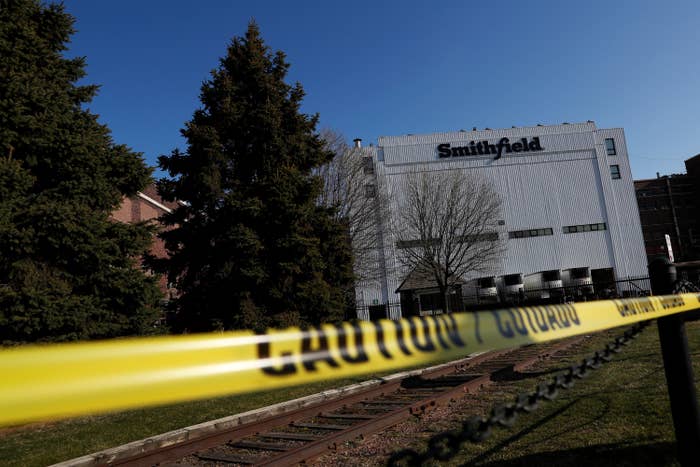
Shannon Stapleton / Reuters
The Smithfield Foods pork plant in South Dakota is closed indefinitely in the wake of its coronavirus outbreak.
Was there any way to prevent the Smithfield Foods pork processing plant in South Dakota from becoming one of the country’s largest known coronavirus clusters, with more than 700 workers infected? It’s hard to know “what could have been done differently,” a Smithfield spokesperson said, given what she referred to as the plant’s “large immigrant population.”
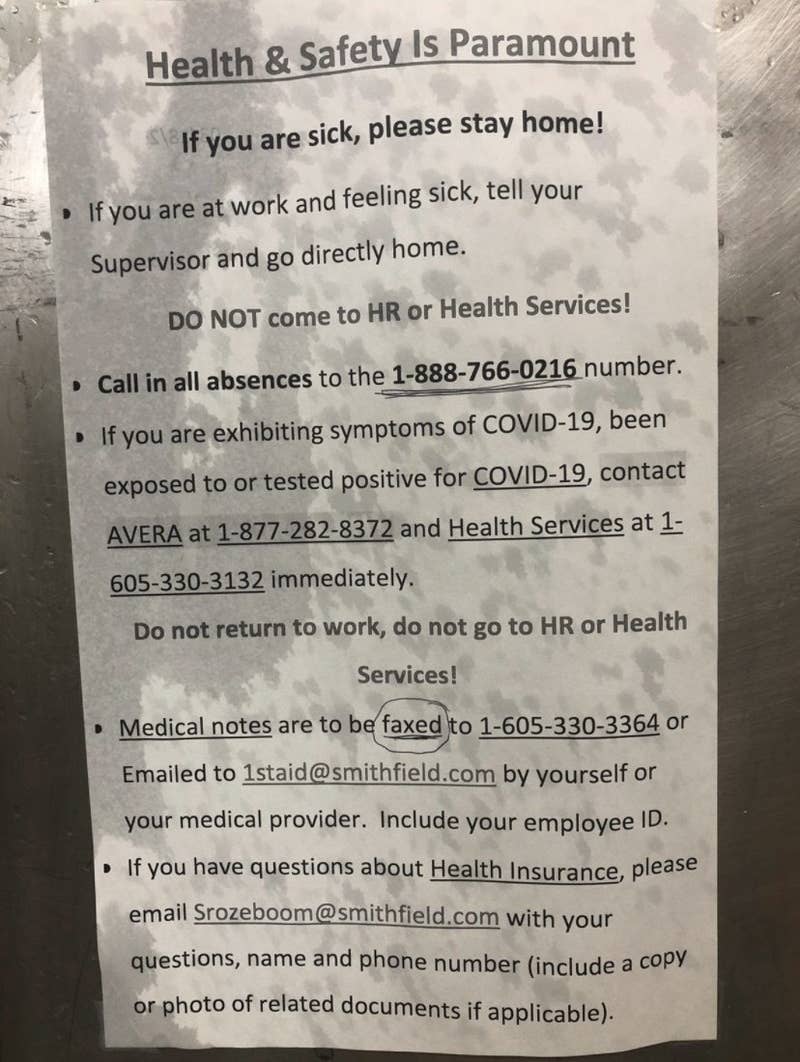
Provided to BuzzFeed News
A flyer at the Smithfield plant.
On April 1, the company took the unusual step of offering free lunch. The gesture was meant to show appreciation for those still coming in — but it was also an incentive for workers from all eight floors to pass through the cafeteria.
On April 6, two weeks after the first confirmed case and with the number of infections rising, Smithfield implemented mandatory temperature checks and shut down at least one floor “for cleaning & sanitation,” according to a company text message to employees. Yet the rest of the plant stayed open.
As more people called in sick, Smithfield management stayed mostly silent about the severity of the crisis at the Sioux Falls facility, only informing employees about a confirmed case if they’d recently been “in contact” with the person, according to the spokesperson, while encouraging others in company text messages to “Please report to work as previously scheduled.”
Eighteen days after the first case, once 238 workers had tested positive, Smithfield paused operations on all floors for 48 hours to deep-clean the plant, as well as install cardboard dividers at workstations and plexiglass shields on cafeteria tables. Even then, it moved slowly: Smithfield announced the temporary closure on April 9 but said it would not occur for another few days to allow for an orderly reduction in supply.
On April 10, Michael Bul Gayo Gatluak, a 22-year-old immigrant from South Sudan, clocked in at the hog kill department on the sixth floor. His job requires him to stand for hours on a platform “really, really close” to other workers along the production line where pig carcasses are chopped. “The job is so heavy,” he said. “You have to breathe so hard.” When he got home that night, he started feeling ill. He said he tested positive for COVID-19 three days later.
“With how we work on the line, I would say I got sick because of them not taking safety measures,” Gatluak told BuzzFeed News. “When they had their first case, I don’t think they acted accordingly.”
Presented with a detailed list of questions, the spokesperson said that it was “purposefully misleading” to portray Smithfield “as reacting to a positive case rather than the very proactive approach” that the company took to the pandemic when it began, but she did not contest any specific facts.
An ongoing BuzzFeed News investigation has exposed how companies around the country have put hourly workers at risk of exposure to the coronavirus. With hundreds of workers in tight confines passing chunks of raw meat through the building, meat processing plants have been especially vulnerable. More than a dozen have fully or partially stopped production since the pandemic began, with hundreds of workers falling ill at plants across the country. Workers at JBS meatpacking plants in Colorado and at a Tyson Foods poultry processing plant in Georgia have died from COVID-19.
But for now, the Smithfield facility in South Dakota stands out. The first case arrived when the pandemic was in full swing, with much of the country shutting down and companies everywhere changing the way they worked. The outbreak spread faster than at any other plant.
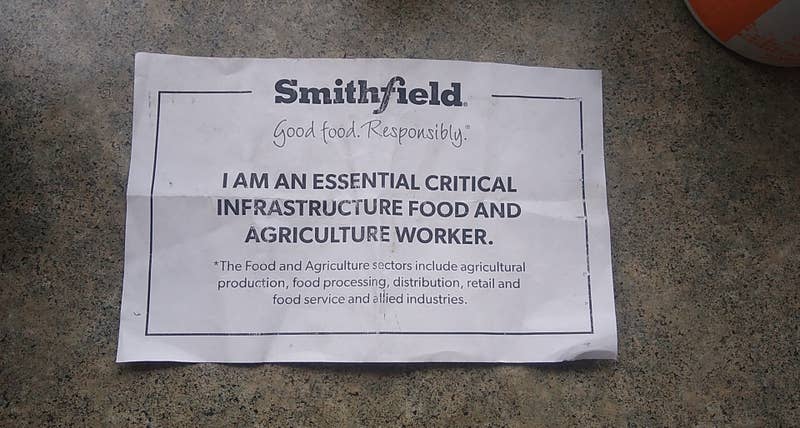
Provided to BuzzFeed New
A letter provided to Smithfield employees for use in case they are asked why they are out.
Gatluak recalled hearing about a confirmed case on March 24 from his manager. Though this was the first known exposure at the facility, the manager announced “no changes” to operations, he said. The English-language notices telling people to go home if they felt ill appeared the next day, Gatluak recalled. “People were still reporting to work normally.”
The Argus Leader, Sioux Falls’ newspaper, broke the news of the first positive case on March 26. The next day, another Smithfield worker who had been out sick for several days began feeling short of breath and drained of energy, barely able to get out of bed, said her 20-year-old daughter, Amy Cruz. She went to the doctor, took a COVID-19 test, and four days later received a positive diagnosis. She immediately called a Smithfield HR representative to convey the result, Cruz said.
In the days that followed, as more workers called in sick with symptoms and tested positive, Smithfield bosses informed only employees “who may have come in contact with that person,” the spokesperson said — not the whole floor. The spokesperson said that exposed employees were placed on two-week paid quarantine leave but declined to say how many there have been.
The rest of the workforce continued on for a week without knowing how many of their colleagues had been infected, and with no additional protective equipment. Like many of the hundreds of thousands of hourly workers who supply the country with food and other necessities, they faced the choice of going without a paycheck or risking their health for jobs that typically pay less than $20 an hour.
Some Smithfield employees who spoke to BuzzFeed News requested anonymity because they feared getting fired, but two allowed their children to discuss the matter openly. For both daughters, Amy Cruz and Sara Telahun Birhe, the Smithfield plant was an ever-present backdrop since their earliest memories
Cruz’s mother, four of her uncles, and an aunt have all worked at the plant for more than two decades since migrating from Guatemala; one of those uncles tested positive two weeks after Cruz’s mother did.
Birhe was 6 when her mother started working at the plant 16 years ago, after emigrating from Ethiopia, where she owned a café. They lived near the facility, in a neighborhood in northeastern Sioux Falls, where Birhe grew close with the children of other Smithfield workers: families from Mexico, Nepal, Honduras, the Democratic Republic of the Congo, El Salvador, and elsewhere. “Family events and birthday parties and weddings and quinceañeras,” she said. “Our parents worked this job, and because of that we were all friends.
Her mom earned $17 an hour, which is nearly double the state's minimum wage, which went a long way in Sioux Falls. Over her years at the plant, she bought a car and a house and saved enough money to pay Birhe’s college tuition. She knew of one former Smithfield worker who went on to open a restaurant, another a grocery store
Birhe and her cousins were used to seeing their parents come home from work exhausted, plopping down on the couch to rest before dinner, going to bed early for 6 a.m. shifts. But their parents’ sacrifice took on a new light when the pandemic reached the Smithfield plant. Birhe recalls a series of conversations with her cousins about whether they should try to get their parents to stop going to work. “Our parents were worried about paying our bills, and we were worried about their health,” she said.
Unemployment benefits aren’t available for people who quit their jobs without being sick or at a high risk, and many at Smithfield had built stable careers with higher pay than what would be available if they started fresh elsewhere. One worker’s daughter, who requested anonymity, said that she, her brother, and her mother had all been laid off or furloughed from their own jobs. For her father, who began at the plant 15 years ago after migrating from Mexico, “it wasn’t an option if you go to work,” she said. “He’s proud of what he does. He feeds so many people.”
Over the week following the first confirmed case at the plant, workers continued to dine in the cafeteria as normal. To keep production flowing seamlessly on all floors, crews synchronized their breaks based on their position on the processing line: On each floor, a team of workers would take lunch once they finished a batch and passed it down to the next team. They filed through hallways and staircases, joining teams from other floors in the sixth-floor cafeteria, which is mostly staffed by immigrants from Latin American countries. Gatluak found the meals delicious, he said: “Every day we get something new.” Three employees estimated that at least 200 people from various floors would be in the cafeteria at any given time.
On April 1, a day after Cruz’s mother tested positive, Smithfield management directed entire floors to take lunch breaks in deliberately staggered shifts to reduce crowds. But alongside those precautions came the announcement that lunch was now free, though some employees preferred to eat their homemade meals in the locker room rather than risk passing through the dining area. A Smithfield representative declined to comment on the free lunch.
Over the next few days, Smithfield started introducing new safety measures. Management put up new flyers encouraging social distancing in the cafeteria and set up tents outside the facility for mandatory temperature checks. Those with a fever were sent home with instructions for where to get tested.

Bloomberg / Getty Images
A sign outside the Smithfield plant notifies employees that their temperatures will be taken before entering work, April 15.
Still, many workers brought their own masks because Smithfield provided only hairnets for their faces. “That doesn’t do any good,” one worker said. And, as the Argus Leader first reported, the company offered a $500 bonus to employees who didn’t miss any shifts in April. “That was not a good move, because if anyone fell sick they’d be like, 'Oh, I have to go to work because I have to get that bonus,'” Gatluak said.
When the company ceased operations on the eighth-floor packing department on April 6, workers assumed it was because of the virus, two employees said. Company text messages noted that the floor was “shut down for cleaning & sanitation”; the department’s workers were told they should not come to work but would be paid for the week. “All other departments will be operating as scheduled,” the message stated. Smithfield did not respond to a question about why it closed that floor and not the other
It is unclear how many cases Smithfield was aware of during this time. The company declined to comment, citing employee privacy protections. But on April 8, the state health department announced an outbreak of 80 confirmed cases at the plant.
The next day, the company announced it would “suspend operations in a large section of the plant” — but not until April 11. Only on April 12 and 13 would the plant “completely shutter” for “rigorous deep cleaning” and the construction of “additional physical barriers to further enhance social distancing.
Gatluak said he clocked in at work on April 10. For weeks, he’d been taking precautions to minimize the chances of exposing his mother and brother at home. He washed his hands regularly and sanitized everything he came into contact with, “from doorknobs to stair rail, the handles, countertops,” he said. “I know I was a risk because of where I was working.”
He began to feel a headache, fever, and chills after returning home from his shift. The next morning he called the hospital, then took a test at a drive-through center.
That day, the number of confirmed cases at the plant hit 190. Still, Smithfield maintained its plans to reopen the plant after the 48-hour shutdown. But on April 11, Sioux Falls Mayor Paul TenHaken and Gov. Kristi Noem published a letter asking Smithfield’s CEO to close the plant for longer. The next day, Smithfield complied, closing it down indefinitely.
The company warned of the economic impact of an extended shutdown.
“It is impossible to keep our grocery stores stocked if our plants are not running,” Smithfield President and CEO Kenneth Sullivan said in a statement that day. “These facility closures will also have severe, perhaps disastrous, repercussions for many in the supply chain, first and foremost our nation’s livestock farmers.”
Two days later, Gatluak said he received his positive test result. He has had relatively mild symptoms. Another member of his crew has also tested positive, he sai
Smithfield workers and their relatives now account for more than half of South Dakota’s confirmed cases, a pool of residents who may soon have the option to volunteer as test subjects for the nation’s first statewide clinical trial for hydroxychloroquine, an antimalarial drug promoted by President Donald Trump as a potential coronavirus treatment but which has not yet been proven as effective against the virus. Noem announced last week that the testing would begin once at least 2,000 people signed up. While 45 states have issued stay-at-home orders, the governor has declined to do so.
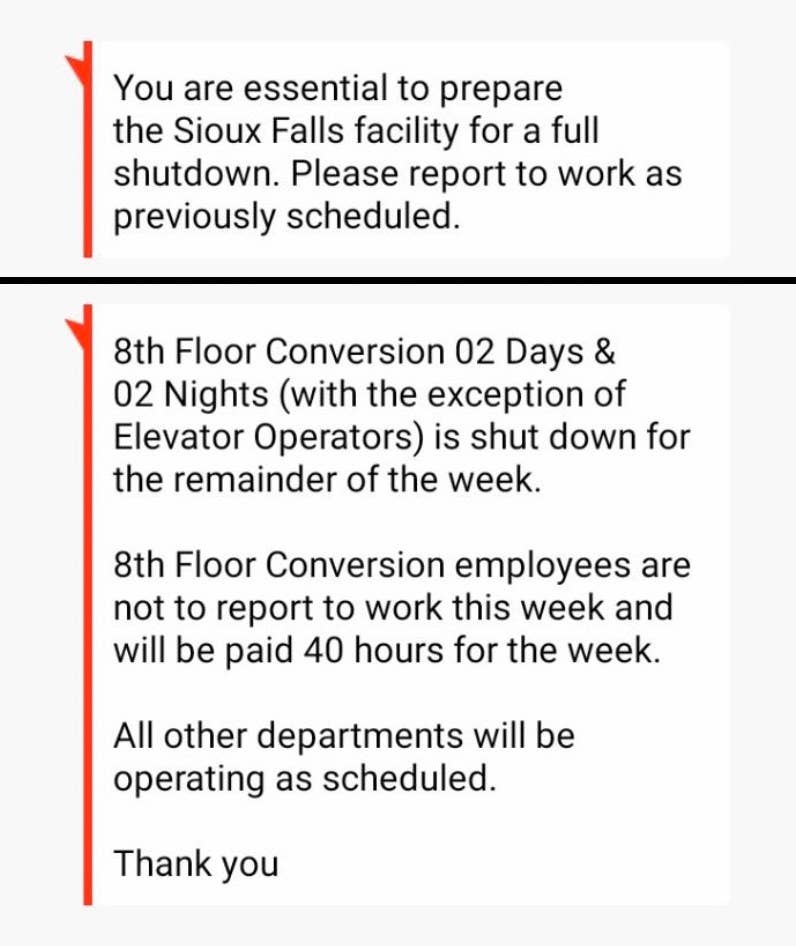
Provided to BuzzFeed News
Text messages sent to Smithfield workers.
On Monday, April 13, a Smithfield worker in his fifties received a company text message: “You are essential to prepare the Sioux Falls facility for a full shutdown. Please report to work on Tuesday as previously scheduled.”
One of around 50 workers at the plant that day, he deboned ham in the basement freezer and filled in on several other jobs to make up for the reduced staff. Though most of the plant had shut down, his department was near the end of the processing line, just before the meat was packed and loaded. Operations would continue until all the meat in stock had made its way through the system and into the trucks.
He kept the mood light around his children, especially when they expressed concern. When his daughter showed him a news story listing his plant as one of the five biggest outbreaks in the country, he quipped, “Oh boy, I’ve never been in the top five of anything!”
By April 14, Smithfield had built plexiglass barriers on cafeteria tables, installed cardboard dividers between worker stations, and provided plastic face shields. The basement worker ate his lunch in the locker room, as he had every day in recent weeks. He worked 13 hours that shift, until every piece of pork passing through his station was packaged.
When he returned home, he took a seat at the kitchen table, his shoulders slumped, and told his family he didn’t have to go into work anymore.
“He was just so relieved,” his daughter recalled. “I’ve never seen him so tired.”
When she asked him if everyone else was done too, he shook his head and said, “Others still need to go in tomorrow.” ●

Shannon Stapleton / Reuters
The Smithfield Foods pork plant in South Dakota is closed indefinitely in the wake of its coronavirus outbreak.
Was there any way to prevent the Smithfield Foods pork processing plant in South Dakota from becoming one of the country’s largest known coronavirus clusters, with more than 700 workers infected? It’s hard to know “what could have been done differently,” a Smithfield spokesperson said, given what she referred to as the plant’s “large immigrant population.”
“Living circumstances in certain cultures are different than they are with your traditional American family,” she explained. The spokesperson and a second corporate representative pointed to an April 13 Fox News interview in which the governor of South Dakota, Kristi Noem, said that “99%” of the spread of infections “wasn’t happening inside the facility” but inside workers’ homes, “because a lot of these folks who work at this plant live in the same community, the same buildings, sometimes in the same apartments."
In late March, as word of the first confirmed case leaked, workers began seeing flyers on notice boards and doors. “If you are at work and feeling sick,” the flyers stated, “tell your Supervisor and go directly home.” But the directive was posted only in English, three employees said, even though many of the plant’s 3,700 workers have limited comprehension of English. Safety notices at the plant are usually translated into as many as five languages.
But internal company communications and interviews with nearly a dozen workers and their relatives point to a series of management missteps and half measures that contributed significantly to the spread of the virus. A BuzzFeed News investigation has uncovered new information showing the company did little to inform or protect employees during the critical two weeks after the first case at the plant surfaced. Then, with confirmed cases rising quickly, Smithfield introduced new safety protocols but applied them unevenly across the plant’s departments, leaving hundreds of workers exposed.

Provided to BuzzFeed News
A flyer at the Smithfield plant.
On April 1, the company took the unusual step of offering free lunch. The gesture was meant to show appreciation for those still coming in — but it was also an incentive for workers from all eight floors to pass through the cafeteria.
On April 6, two weeks after the first confirmed case and with the number of infections rising, Smithfield implemented mandatory temperature checks and shut down at least one floor “for cleaning & sanitation,” according to a company text message to employees. Yet the rest of the plant stayed open.
As more people called in sick, Smithfield management stayed mostly silent about the severity of the crisis at the Sioux Falls facility, only informing employees about a confirmed case if they’d recently been “in contact” with the person, according to the spokesperson, while encouraging others in company text messages to “Please report to work as previously scheduled.”
Eighteen days after the first case, once 238 workers had tested positive, Smithfield paused operations on all floors for 48 hours to deep-clean the plant, as well as install cardboard dividers at workstations and plexiglass shields on cafeteria tables. Even then, it moved slowly: Smithfield announced the temporary closure on April 9 but said it would not occur for another few days to allow for an orderly reduction in supply.
On April 10, Michael Bul Gayo Gatluak, a 22-year-old immigrant from South Sudan, clocked in at the hog kill department on the sixth floor. His job requires him to stand for hours on a platform “really, really close” to other workers along the production line where pig carcasses are chopped. “The job is so heavy,” he said. “You have to breathe so hard.” When he got home that night, he started feeling ill. He said he tested positive for COVID-19 three days later.
“With how we work on the line, I would say I got sick because of them not taking safety measures,” Gatluak told BuzzFeed News. “When they had their first case, I don’t think they acted accordingly.”
The plant is now closed indefinitely, cutting the country off from about 5% of its national pork supply. With 725 confirmed cases among workers and 143 more traced to them, the Smithfield outbreak has eclipsed most of the country’s worst-hit nursing homes and prisons among the largest community outbreaks. One Smithfield worker, 64-year-old Agustin Rodriguez, died on April 14 from COVID-19 complications.Smithfield denied that company policies contributed to the spread of the virus, and said that it has prioritized employees’ well-being and communicated with them extensively about safety protocols. The corporate spokesperson whom the company provided to answer BuzzFeed News’ questions — on the condition that her name not be used — said that higher-ups have worked “around the clock” from the beginning of the outbreak and posted handwashing directives as early as February, but have been hindered by national shortages of protective equipment. Last week, Smithfield shut down plants in Wisconsin and Missouri after employees there tested positive for COVID-19, and announced it was providing all 40,000 company employees with “a $100 million Responsibility Bonus,” which amounts to around $2,500 per person.
Presented with a detailed list of questions, the spokesperson said that it was “purposefully misleading” to portray Smithfield “as reacting to a positive case rather than the very proactive approach” that the company took to the pandemic when it began, but she did not contest any specific facts.
An ongoing BuzzFeed News investigation has exposed how companies around the country have put hourly workers at risk of exposure to the coronavirus. With hundreds of workers in tight confines passing chunks of raw meat through the building, meat processing plants have been especially vulnerable. More than a dozen have fully or partially stopped production since the pandemic began, with hundreds of workers falling ill at plants across the country. Workers at JBS meatpacking plants in Colorado and at a Tyson Foods poultry processing plant in Georgia have died from COVID-19.
But for now, the Smithfield facility in South Dakota stands out. The first case arrived when the pandemic was in full swing, with much of the country shutting down and companies everywhere changing the way they worked. The outbreak spread faster than at any other plant.

Provided to BuzzFeed New
A letter provided to Smithfield employees for use in case they are asked why they are out.
Gatluak recalled hearing about a confirmed case on March 24 from his manager. Though this was the first known exposure at the facility, the manager announced “no changes” to operations, he said. The English-language notices telling people to go home if they felt ill appeared the next day, Gatluak recalled. “People were still reporting to work normally.”
The Argus Leader, Sioux Falls’ newspaper, broke the news of the first positive case on March 26. The next day, another Smithfield worker who had been out sick for several days began feeling short of breath and drained of energy, barely able to get out of bed, said her 20-year-old daughter, Amy Cruz. She went to the doctor, took a COVID-19 test, and four days later received a positive diagnosis. She immediately called a Smithfield HR representative to convey the result, Cruz said.
In the days that followed, as more workers called in sick with symptoms and tested positive, Smithfield bosses informed only employees “who may have come in contact with that person,” the spokesperson said — not the whole floor. The spokesperson said that exposed employees were placed on two-week paid quarantine leave but declined to say how many there have been.
The rest of the workforce continued on for a week without knowing how many of their colleagues had been infected, and with no additional protective equipment. Like many of the hundreds of thousands of hourly workers who supply the country with food and other necessities, they faced the choice of going without a paycheck or risking their health for jobs that typically pay less than $20 an hour.
Some Smithfield employees who spoke to BuzzFeed News requested anonymity because they feared getting fired, but two allowed their children to discuss the matter openly. For both daughters, Amy Cruz and Sara Telahun Birhe, the Smithfield plant was an ever-present backdrop since their earliest memories
Cruz’s mother, four of her uncles, and an aunt have all worked at the plant for more than two decades since migrating from Guatemala; one of those uncles tested positive two weeks after Cruz’s mother did.
Birhe was 6 when her mother started working at the plant 16 years ago, after emigrating from Ethiopia, where she owned a café. They lived near the facility, in a neighborhood in northeastern Sioux Falls, where Birhe grew close with the children of other Smithfield workers: families from Mexico, Nepal, Honduras, the Democratic Republic of the Congo, El Salvador, and elsewhere. “Family events and birthday parties and weddings and quinceañeras,” she said. “Our parents worked this job, and because of that we were all friends.
Her mom earned $17 an hour, which is nearly double the state's minimum wage, which went a long way in Sioux Falls. Over her years at the plant, she bought a car and a house and saved enough money to pay Birhe’s college tuition. She knew of one former Smithfield worker who went on to open a restaurant, another a grocery store
Birhe and her cousins were used to seeing their parents come home from work exhausted, plopping down on the couch to rest before dinner, going to bed early for 6 a.m. shifts. But their parents’ sacrifice took on a new light when the pandemic reached the Smithfield plant. Birhe recalls a series of conversations with her cousins about whether they should try to get their parents to stop going to work. “Our parents were worried about paying our bills, and we were worried about their health,” she said.
Unemployment benefits aren’t available for people who quit their jobs without being sick or at a high risk, and many at Smithfield had built stable careers with higher pay than what would be available if they started fresh elsewhere. One worker’s daughter, who requested anonymity, said that she, her brother, and her mother had all been laid off or furloughed from their own jobs. For her father, who began at the plant 15 years ago after migrating from Mexico, “it wasn’t an option if you go to work,” she said. “He’s proud of what he does. He feeds so many people.”
Over the week following the first confirmed case at the plant, workers continued to dine in the cafeteria as normal. To keep production flowing seamlessly on all floors, crews synchronized their breaks based on their position on the processing line: On each floor, a team of workers would take lunch once they finished a batch and passed it down to the next team. They filed through hallways and staircases, joining teams from other floors in the sixth-floor cafeteria, which is mostly staffed by immigrants from Latin American countries. Gatluak found the meals delicious, he said: “Every day we get something new.” Three employees estimated that at least 200 people from various floors would be in the cafeteria at any given time.
On April 1, a day after Cruz’s mother tested positive, Smithfield management directed entire floors to take lunch breaks in deliberately staggered shifts to reduce crowds. But alongside those precautions came the announcement that lunch was now free, though some employees preferred to eat their homemade meals in the locker room rather than risk passing through the dining area. A Smithfield representative declined to comment on the free lunch.
Over the next few days, Smithfield started introducing new safety measures. Management put up new flyers encouraging social distancing in the cafeteria and set up tents outside the facility for mandatory temperature checks. Those with a fever were sent home with instructions for where to get tested.

Bloomberg / Getty Images
A sign outside the Smithfield plant notifies employees that their temperatures will be taken before entering work, April 15.
Still, many workers brought their own masks because Smithfield provided only hairnets for their faces. “That doesn’t do any good,” one worker said. And, as the Argus Leader first reported, the company offered a $500 bonus to employees who didn’t miss any shifts in April. “That was not a good move, because if anyone fell sick they’d be like, 'Oh, I have to go to work because I have to get that bonus,'” Gatluak said.
When the company ceased operations on the eighth-floor packing department on April 6, workers assumed it was because of the virus, two employees said. Company text messages noted that the floor was “shut down for cleaning & sanitation”; the department’s workers were told they should not come to work but would be paid for the week. “All other departments will be operating as scheduled,” the message stated. Smithfield did not respond to a question about why it closed that floor and not the other
It is unclear how many cases Smithfield was aware of during this time. The company declined to comment, citing employee privacy protections. But on April 8, the state health department announced an outbreak of 80 confirmed cases at the plant.
The next day, the company announced it would “suspend operations in a large section of the plant” — but not until April 11. Only on April 12 and 13 would the plant “completely shutter” for “rigorous deep cleaning” and the construction of “additional physical barriers to further enhance social distancing.
Gatluak said he clocked in at work on April 10. For weeks, he’d been taking precautions to minimize the chances of exposing his mother and brother at home. He washed his hands regularly and sanitized everything he came into contact with, “from doorknobs to stair rail, the handles, countertops,” he said. “I know I was a risk because of where I was working.”
He began to feel a headache, fever, and chills after returning home from his shift. The next morning he called the hospital, then took a test at a drive-through center.
That day, the number of confirmed cases at the plant hit 190. Still, Smithfield maintained its plans to reopen the plant after the 48-hour shutdown. But on April 11, Sioux Falls Mayor Paul TenHaken and Gov. Kristi Noem published a letter asking Smithfield’s CEO to close the plant for longer. The next day, Smithfield complied, closing it down indefinitely.
The company warned of the economic impact of an extended shutdown.
“It is impossible to keep our grocery stores stocked if our plants are not running,” Smithfield President and CEO Kenneth Sullivan said in a statement that day. “These facility closures will also have severe, perhaps disastrous, repercussions for many in the supply chain, first and foremost our nation’s livestock farmers.”
Two days later, Gatluak said he received his positive test result. He has had relatively mild symptoms. Another member of his crew has also tested positive, he sai
Smithfield workers and their relatives now account for more than half of South Dakota’s confirmed cases, a pool of residents who may soon have the option to volunteer as test subjects for the nation’s first statewide clinical trial for hydroxychloroquine, an antimalarial drug promoted by President Donald Trump as a potential coronavirus treatment but which has not yet been proven as effective against the virus. Noem announced last week that the testing would begin once at least 2,000 people signed up. While 45 states have issued stay-at-home orders, the governor has declined to do so.

Provided to BuzzFeed News
Text messages sent to Smithfield workers.
On Monday, April 13, a Smithfield worker in his fifties received a company text message: “You are essential to prepare the Sioux Falls facility for a full shutdown. Please report to work on Tuesday as previously scheduled.”
One of around 50 workers at the plant that day, he deboned ham in the basement freezer and filled in on several other jobs to make up for the reduced staff. Though most of the plant had shut down, his department was near the end of the processing line, just before the meat was packed and loaded. Operations would continue until all the meat in stock had made its way through the system and into the trucks.
He kept the mood light around his children, especially when they expressed concern. When his daughter showed him a news story listing his plant as one of the five biggest outbreaks in the country, he quipped, “Oh boy, I’ve never been in the top five of anything!”
By April 14, Smithfield had built plexiglass barriers on cafeteria tables, installed cardboard dividers between worker stations, and provided plastic face shields. The basement worker ate his lunch in the locker room, as he had every day in recent weeks. He worked 13 hours that shift, until every piece of pork passing through his station was packaged.
When he returned home, he took a seat at the kitchen table, his shoulders slumped, and told his family he didn’t have to go into work anymore.
“He was just so relieved,” his daughter recalled. “I’ve never seen him so tired.”
When she asked him if everyone else was done too, he shook his head and said, “Others still need to go in tomorrow.” ●

Albert Samaha is an investigative reporter for BuzzFeed News and is based in New York.

Katie Baker is an investigative reporter for BuzzFeed News and is based in London.
MORE ON THIS
Costco Is Thriving During The Coronavirus Pandemic. Its Workers Say They’ve Paid The Price.
Costco Is Thriving During The Coronavirus Pandemic. Its Workers Say They’ve Paid The Price.
Brianna Sacks · April 16, 2020
Despite The New Coronavirus Law, Workers At These Big Companies Say They Still Must Work Sick Or Lose Pay
Despite The New Coronavirus Law, Workers At These Big Companies Say They Still Must Work Sick Or Lose Pay
Albert Samaha · April 10, 2020
Starbucks Employees Got Sick. Starbucks Stores Stayed Open.
Starbucks Employees Got Sick. Starbucks Stores Stayed Open.
Albert Samaha · March 26, 2020
Trader Joe’s Workers Are Terrified Not Enough Is Being Done To Keep Them And Customers Safe
Trader Joe’s Workers Are Terrified Not Enough Is Being Done To Keep Them And Customers Safe
Julia Reinstein · March 31, 2020
Coronavirus In The Workplace: BuzzFeed News looks at how companies and employees are handling the coronavirus pandemic.
Costco Made Corporate Staff Come To The Office. An Employee Died Of COVID-19. The Office Is Still Open.
These Retailers Have Been Staying Open. Employees Say They’re Afraid For Themselves And Others.
They Work Inside Target Stores — With Fewer Coronavirus Protections Than Target Employees
As More Amazon Employees Contract The Coronavirus, Workers Are Walking Off The Job
Aazon Said That During The Pandemic, Sales Are Soaring. Workers Say They Feel Unsafe.m
SEE
https://plawiuk.blogspot.com/search?q=SMITHFIELD
https://plawiuk.blogspot.com/search?q=TYSON
https://plawiuk.blogspot.com/search?q=MEAT+PACKING
https://plawiuk.blogspot.com/search?q=COVID19
https://plawiuk.blogspot.com/search?q=JBS
Costco Made Corporate Staff Come To The Office. An Employee Died Of COVID-19. The Office Is Still Open.
These Retailers Have Been Staying Open. Employees Say They’re Afraid For Themselves And Others.
They Work Inside Target Stores — With Fewer Coronavirus Protections Than Target Employees
As More Amazon Employees Contract The Coronavirus, Workers Are Walking Off The Job
Aazon Said That During The Pandemic, Sales Are Soaring. Workers Say They Feel Unsafe.m
SEE
https://plawiuk.blogspot.com/search?q=SMITHFIELD
https://plawiuk.blogspot.com/search?q=TYSON
https://plawiuk.blogspot.com/search?q=MEAT+PACKING
https://plawiuk.blogspot.com/search?q=JBS

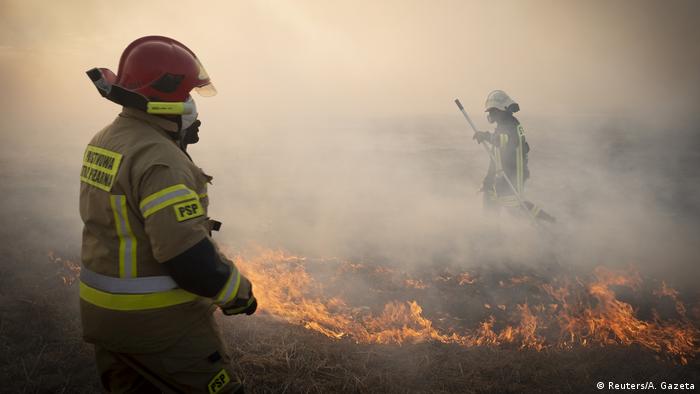
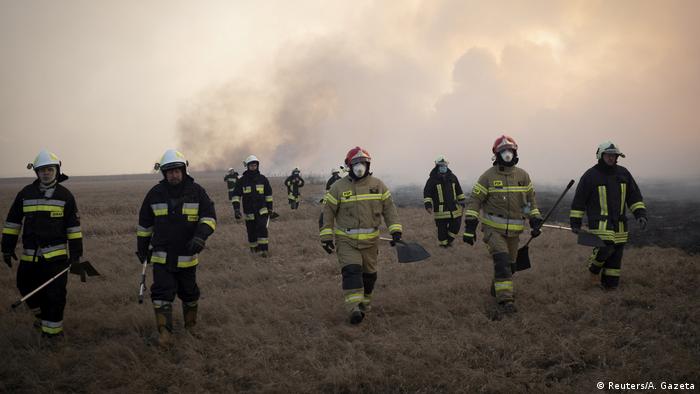

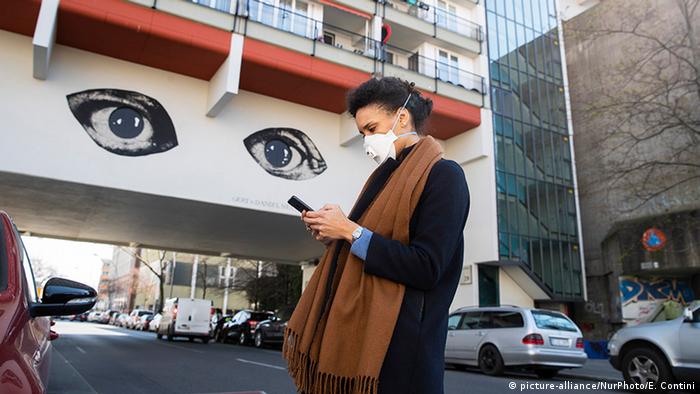


.webp)
